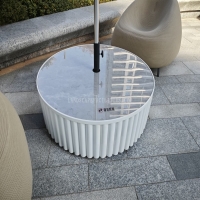Welcome to the website for landscape facilities products and knowledge.
What are the most important factors to consider when selecting the table for a religious or spiritual gathering space?
The selection of a table for religious or spiritual gatherings transcends mere furniture choice—it becomes a sacred decision that impacts the entire worship experience. Unlike conventional tables, these surfaces serve as focal points for ceremony, ritual, and community connection. Several crucial factors demand careful consideration to ensure the table harmonizes with both practical needs and spiritual significance.
First and foremost, symbolism and sacred geometry must guide the selection process. The table's shape carries profound meaning: rectangular tables often represent community and shared journey, circular designs symbolize eternity and unity, while square configurations may signify stability and the four directions or elements. The dimensions should reflect sacred ratios found in religious architecture, creating visual harmony that resonates subconsciously with congregants. Many traditions specify numerical significance in measurements, connecting the physical object to spiritual principles.
Material selection forms another critical consideration, balancing durability with symbolic meaning. Solid wood offers warmth and natural energy, with specific wood types holding traditional significance—oak for strength, cedar for purification, or olive wood for peace. Stone surfaces convey permanence and connection to the earth, while metals may be chosen for their reflective qualities or ceremonial importance. The material's sustainability and ethical sourcing increasingly matter to communities seeking to align their physical spaces with spiritual values.
Functionality must serve rather than dominate the spiritual purpose. Consider the primary activities: Will the table hold religious texts, ceremonial objects, or serve as an altar? Does it need storage for sacred items? The height should accommodate both seated and standing rituals, while the surface area must comfortably contain necessary elements without appearing cluttered. Accessibility ensures all participants, including those with mobility challenges, can fully engage with ceremonies centered around the table.
Aesthetic integration with the surrounding space proves equally important. The table should complement architectural elements, color schemes, and lighting conditions while maintaining its position as the visual anchor. Ornamentation—whether carvings, inlays, or symbolic markings—should enhance rather than distract from its sacred function. The finish and color either blend harmoniously with the environment or provide meaningful contrast according to liturgical traditions.
Finally, contemplate the table's energetic presence and longevity. A well-chosen table becomes imbued with the prayers, ceremonies, and intentions conducted around it through years of use. Invest in quality craftsmanship that will endure both physically and energetically, creating a legacy object that grows in spiritual significance with each gathering. The perfect religious gathering table disappears as mere furniture and emerges as a sacred centerpoint that supports, contains, and elevates spiritual practice for all who gather around it.
Related search:

Recommendation
Round metal tube border design table with tempered glass or granite countertop on the top.